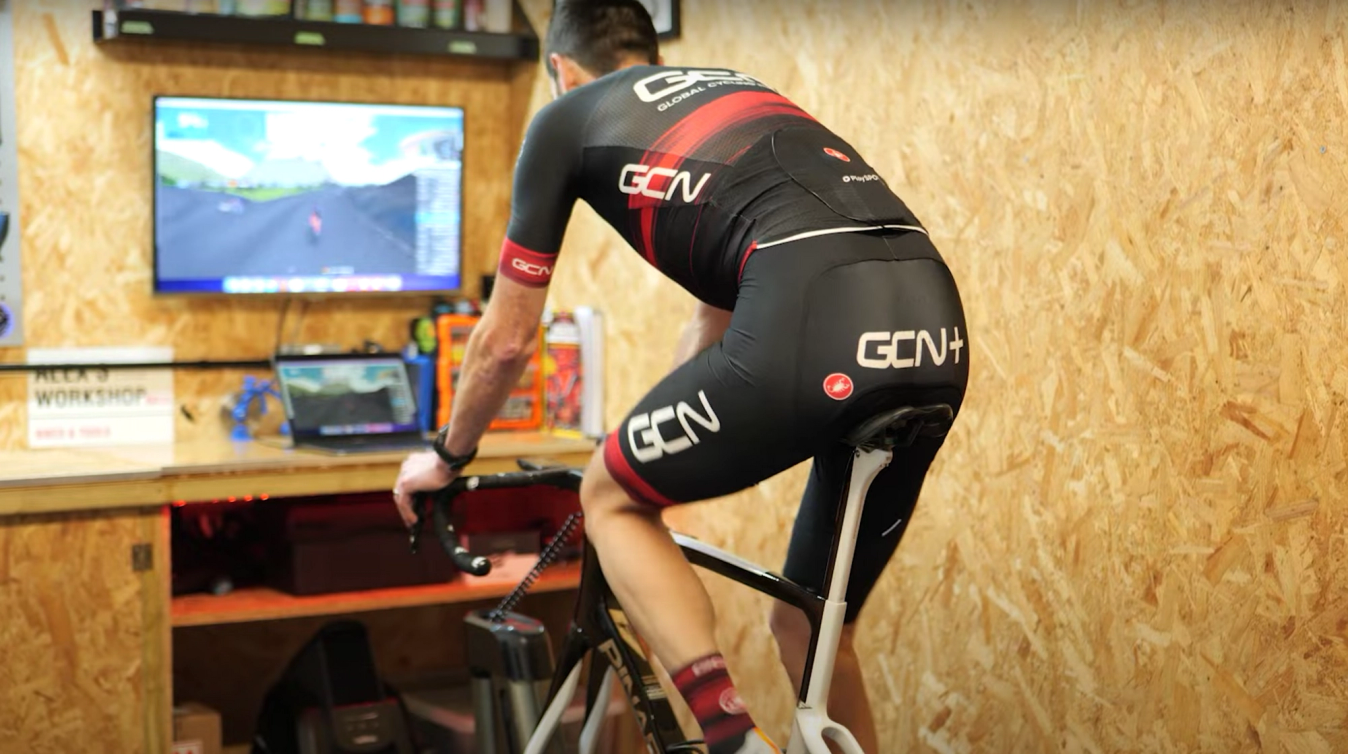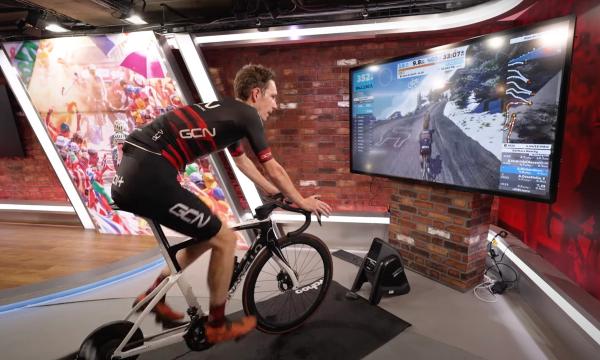Permanent vs temporary indoor cycling set-up: Which pain cave is best?
To make the most of indoor training, you’ll need to find a set-up that is easy to use and convenient
Tom Hallam-Gravells
Online Production Editor
Most cyclists aren’t particularly enthusiastic about suffering through rain and the cold. That’s why, almost like clockwork, they participate in a mass hibernation indoors as soon as the crisp air of autumn arrives.
With the help of a turbo trainer, it’s possible to fulfil all of your cycling needs without leaving the house. It’s weather-proof, easy and, in most cases, a convenient way of training. However, this level of convenience will depend on your indoor training set-up.
- Read more: GCN's ultimate guide to indoor cycling
This is a shootout between a permanent pain cave or something temporary that has to be set up each time you want to train. Both have their advantages depending on an individual’s needs, and what space you have available to you, so which one should you choose?
Here’s a closer look at two opposing set-ups used by GCN’s Alex Paton and Matt Larkin, and why their respective set-up works for them.
- Read more: The ultimate pain cave: How to set up your training space for the best indoor cycling experience
Permanent pain cave: Alex Paton
What is the set-up?
Starting with a familiar face: Alex Paton.
Alex has converted his garage into a permanent pain cave, which also doubles up as storage for all of his bikes and equipment. It may look familiar as some GCN Tech videos are also shot there.
For his set-up, Alex has the latest Wahoo Kickr Move with its built-in dual-axis movement, which essentially allows the bike to move backwards and forwards for a more realistic ride feel. It’s on the larger side with a big footprint, so it is more suited to a permanent set-up than a temporary one.
That’s paired with the Wahoo Kickr Climb, which raises the front of the bike to replicate virtual gradients, while cooling it is taken care of by the Wahoo Kickr 'Headwind' Fan. Once paired up with the turbo trainer, the output can be controlled from the head unit.
How does your set-up work?
Alex Paton: As a general rule of thumb, once the weather turns bad in winter time, I try to have at least one [turbo trainer] set up and ready to go. Chloe quite often rides the trainer, and so do I, and sometimes we have a second one out so that we can have two trainers going at the same time.
Now and again I have to pack it all away because we’ll be filming and stuff, so it’s not 100% permanent. But generally, it sits there ready to go.
What are the benefits of the set-up?
Alex: It’s a super, mega luxury to have. But I think, for me, ease of use is most important. There’s only so much drive and motivation you can have to want to ride indoors, so why use a little bit of that up setting everything up, when you can just come in, jump on, and away you go?
Are there any downsides to your set-up?
Alex: With a permanent set-up like this, there's no getting around it: it's going to cost you a bit of money, which for some people will be worth it, but for others it won't, if you just won't utilize it.

© GCN
Pain caves can have some downsides
Second of all, if I do have to tidy everything away, which I do now and again, it’s actually a massive job to put it all away and then get it set back up again. That’s quite a frustration for me.
How often do you need to ride to make this permanent set-up worthwhile?
Alex: It’s going to vary for everybody. Unless you’re planning on riding this set-up at least three times a week, I think there’s probably a valid argument for thinking that you should probably have a dialled-back, easier, smaller and more reserved set-up that you can just get in and tuck away, making life a little bit easier.
Temporary indoor cycling set-up: Matt Larkin
What is the set-up?
Unlike Alex, Matt Larkin, who also works for GCN, doesn’t have the luxury of having a spare garage. His house is also pretty full up too. The only room he has for turbo training is his home office, which doubles up as a temporary pain cave. This means having to set the turbo trainer up and take it down for each ride.
With its slightly more compact design, the Wahoo Kickr Core works well for this, as it neatly fits under his desk. Similarly to Alex’s set-up, it’s paired with a Wahoo fan and a mat - if you don’t want to damage your floor, a mat is essential.
- Read more: Which Wahoo smart trainer is best for you?

© GCN
Matt stores everything under his desk
Having a set-up like this is both convenient and inconvenient at the same time. It obviously requires time to set up each time you want to train, but you also don’t have to reserve a full room for a pain cave. In Matt’s case, this time inconvenience is only minimal, and he reckons that he can set it up in as little as five minutes.
What tips would you give to cyclists who are considering a temporary set-up?
Matt Larkin: I think having everything in the room organised, so you know exactly where it is, that is really important. Things about my set-up that help: I think having the Wahoo Kickr Core is really helpful because it’s quite easy to move around. It doesn’t take up too much room under my desk and it’s pretty easy to get out and get going on it, so that’s a big thing for me.
There are other things, that can also be disadvantages at some times, that also help me get on and do it. The fact I have to work around other people and tell anybody that I’m going to get on and train, that kind of makes me get on and train sometimes when I might be thinking otherwise. That actually is sort of an advantage to this set-up for me.
What are the disadvantages of your set-up?
Matt: Co-existing with other people. I can’t always train when I want to.
Sometimes, when I don’t announce it, I’ve had some funny instances when kids have come back from school with a friend, come through the front door, and dad’s in the middle of a VO2 max interval, just five feet from the door. That’s a little bit weird, sometimes. But generally, I don’t find that there are too many disadvantages.

© GCN
Matt's home office doubles up as a pain cave
Would you swap to a permanent pain cave if you could?
Matt: You get sucked into Instagram and social media and look at all these amazing pain caves people have. They do look amazing, but if I had that space I would probably do something different with it.
This is what I need. I’m not competing, I’m not racing, I’m just riding for fun and this is just to help me stay on top of my fitness. I don’t want it to dominate my life any more than this. This is part of me enjoying cycling and being outdoors and all the rest of it. It just helps keep me going.
Which of these indoor set-ups do you prefer and what type of set-up do you have? Let us know in the comments.
Need more indoor cycling help or inspiration? GCN's ultimate guide to indoor cycling has you covered with advice and guides on everything from turbo training tech to workouts. Check it out here.










.jpg?w=600&auto=format)



